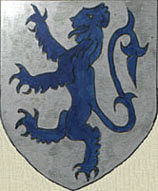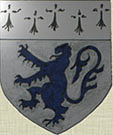BULMER'S DIRECTORY
Skelton is lit by gas and supplied with water.
There is a 'mission room' at North Skelton.
The Post Office is also the Telegraph Office.
Post arrives at 5.30am and is despatched at 9.30am and 6.25pm.
Agricultural Society Show is held each July - Hon Secretary Thomas Petch.
The following persons are recorded:-
OLD SKELTON
The Castle - John Thomas Wharton. JP, William Henry A Wharton.
Bridge House - Harry Pacey, Huntsman.
Old Royal George - Noah House, Victualler.
Estate Office - Edward Hamilton Bell, Steward.
7 Green Rd - Samuel Hewling, Bootmaker.
The Rectory - Rev Robert James Ellis, Curate.
The Kennels - John Pennington, Keeper.
Duke William - Alex Cromar, Victualler.
Estate Saw Mills - William Woodhouse, Joiner.
Back Lane - Robert Ward, Grocer.
|

Police Station, First Left. Then a Butcher's, then a General Dealer.
|
Police Station - Sergeant Thomas Imeson,
Constable Richard Brough and Constable Devany.
1 High St - George Robinson, Cabinetmaker.
3 High St - William Wrightson, Blacksmith.
9 High St - George Robson, Butcher.
11 High St - James Watson, Butcher.
13 High St - Charles Kidd, Fruiterer.
15 High St - Henry Pattinson, Saddler.
21 High St - John Lowe, Tailor.
30 High St - John Carter.
|

A Ellis, Dispensing Chemist. [By the time of this photograph it was Kingston's]
|
32 High St - Christiana Wardman, Dressmaker.
34 High St - George Mclane, Blacksmith.
40 High St - Emily Craven.
44 High St - Rebecca Codling, Dressmaker.
49 High St - William Ridsdale, Builder.
55 High St - Robert Tate, Cart owner.
67 High St - Robert Bell, Music Teacher.
69 High St - Christopher Outwaite, Joiner.
72 High St - Alexander Ellis, Chemists, Registrar of Births and Deaths, Vaccination Officer. Post Office and Savings Bank
74 High St - John George Mitchell, Tailor, clothier and Boot dealer.
80 High St - Addison Tate, Painter and Glazier.
83 High St - John Gatenby Bolton, Cashier.
87 High St - Joseph Crouch, Newsagent.
89 High St - Matthew Brooksbank.
90 High St - William Brown, Cashier.
91 High St - James Elliott, Cab owner.
97 High St - William Knaggs, Bootmaker and dealer.
103 High St - Mary Elizabeth Crofts, Fancy repository and Milliner.
105 High St - Henry Stephenson, Tailor.
|

Skelton High Street about 1890.
|

Fern Villa.
|
107 High St - George Lamb, Builder.
109 High St - John Featherstone, Bootmaker and dealer.
111 High St - John Wood, Tailor and Draper.
Wharton Arms - John Pattinson, Victualler.
Home Farm - Jeremiah Wilks, Bailiff.
121 High St - William Young, Butcher.
125 High St - Ann Oldroyd, Lodgings.
129 High St - John Wood, Stationer.
149 High St - Elizabeth Mary Blackett, Draper.
151 High St - Dowson Bros Henry and Watson, Drapers and Grocers
163 High St - William Carter, Ironmonger.
169 High St - Mary Collier, Dressmaker and Milliner.
173 High St - Henry Ward, Hairdresser.
Co-op Stores - George Atkinson, Manager.
Co-op Stores - Thomas Ward, Manager.
Flowston, Fern Villa - George Stobbs.
Flowston, Belle Villa - Henry Stobbs.
Dixon Street - Thomas Sharp, Builder.
Rigwood - Edward Hamilton Bell, Castle Estate Agent.
Halfpenny Bridge - Robert Hood, Keeper.
|

John Arthur Dorman 1848 to 1931.
|
Robert Dunning, Fruiterer.
George King, Watchmaker.
George Ridgard, General dealer.
Emily Robinson, Schoolmistress.
Thomas Robinson, Carrier.
Charles Treen, Sgt Instructor, 1st Battalion Volunteer Yorks Regt.
Rushpool Hall - John Arthur Dorman, Ironmaster.
[He was born in 1848 at Ashford, Kent and and when he was aged 22 had been sent up to this area to work in an Iron foundry at Stockton-on-Tees, where a family relative was a partner.
He learned the arts of the trade from the shop floor up and by 1875 was able to form a partnership with Albert de Laude Long and take over the West Marsh Ironworks in Middlesbrough.
By exploiting new steel-making technology their business grew and outstripped others.
In 1902 they merged with Bell Bros and took over the North Eastern Steel Co.
By 1914 they were the largest steel producers in Britain and employed over 20,000 people.
Dormanstown was built close to their Redcar works to house many of their employees.
The firm made a fortune during the War supplying the bulk of the vast number of shells that were fired.
His son was killed in the First War and in his memory he gave the Dorman Museum to the town of Middlesbrough.
The Company of Dorman-Long made the steel for many national structures including in Middlesbrough the Newport and Transporter bridges and in Australia in 1932 the famous Sydney Harbour Bridge.
John Arthur was just leasing Rushpool off the Bell family, who returned there until the fire of 1904.
When he died in 1931 Arthur was living at Grey Towers, Nunthorpe, Middlesbrough.]
|
|



